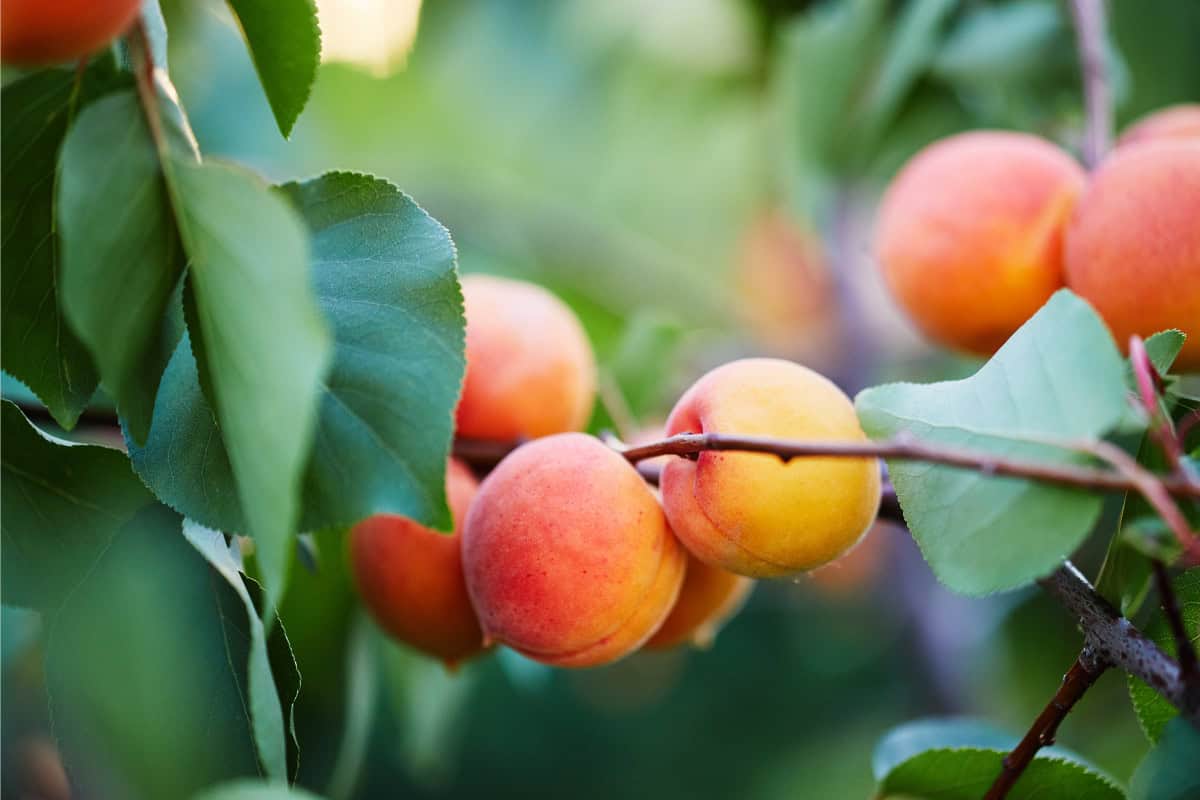
This comprehensive Apricot firewood profile explores the aromatic jewel of fruit wood burning, delivering 18,000-20,000 BTUs per cord with moderate splitting characteristics and distinctive sweet fragrance properties.
Known for its exceptional aromatic qualities and prized cooking applications, Apricot offers premium performance that excels in culinary and ambiance applications while providing natural sweet fragrance from orchard environments.
Quick Reference Stats
- Wood Type: Hardwood (deciduous fruit tree)
- BTU Rating: 18,000-20,000 BTUs per cord
- Ease of Splitting: Moderate (3.5/5 scale)
- Seasoning Time: 8-12 months
- Smoke Production: Low to Moderate
- Spark/Pop Factor: Low
- Scent Profile: Distinctive – Sweet, fruity fragrance with mild floral notes
Overview & Identification
Apricot stands as premium aromatic firewood among fruit trees, offering exceptional burning capabilities from one of the most prized culinary woods available.
This moderately dense hardwood provides good heat output with distinctive sweet fragrance that transforms any fire into an aromatic culinary experience.
The distinctive reddish-brown bark and small tree stature with fragrant white or pink flowers make identification straightforward for this valuable orchard species.
Common Names: Apricot, Apricot Tree, Common Apricot
Scientific Name: Prunus armeniaca (family Rosaceae)
Tree Characteristics: Small to medium tree reaching 15-30 feet with distinctive reddish-brown bark and small, oval leaves. Produces fragrant white or pink flowers and distinctive orange fruit.
Geographic Distribution
Where You’ll Find It: Cultivated throughout temperate regions, particularly western United States, with wild populations in some areas
Availability: Limited availability from orchard removals, pruning operations, and specialty sources
Growing Conditions: Prefers well-drained soils and moderate climates. Commonly grown in orchard settings and requires protection from harsh weather.
Burning Characteristics
Heat Output & Performance
- BTU Content: Good performance suitable for heating and premium cooking applications
- Burn Duration: Burns at moderate rate with good duration for fruit wood
- Coaling Properties: Forms good coals that provide excellent heat retention
- Flame Characteristics: Produces steady, aromatic flames with consistent heat delivery
Ignition & Fire Management
- Ease of Lighting: Good ignition properties – lights reliably and sustains well
- Best Fire Stage: Excellent for cooking applications and aromatic burning
- Burn Rate: Moderate burning provides sustained heat with aromatic benefits
- Heat Consistency: Delivers consistent heat output with steady aromatic experience
Sensory Experience
Smoke Profile
- Smoke Volume: Low to moderate smoke production with exceptional aromatic characteristics
- Smoke Color: Light, sweet smoke with excellent dispersal and pleasant appearance
- Smoke Flavor: Distinctive sweet, fruity flavor highly prized for culinary smoking
- Creosote Production: Low due to clean burning properties and fruit wood characteristics
Sound & Visual
- Crackling/Popping: Gentle crackling with minimal popping and very low sparking
- Sparking Tendency: Very low spark production due to dense fruit wood characteristics
- Flame Appearance: Steady, aromatic flames with excellent visual appeal
Aroma
- Burning Scent: Sweet, distinctive fruity fragrance with mild floral undertones
- Pleasant Factor: Highly prized for culinary aromatherapy and gourmet cooking ambiance
- Intensity: Moderate to strong aromatic presence that enhances cooking and fire experience
Processing & Preparation
Splitting Characteristics
- Ease of Splitting: Moderate splitting due to density and occasionally twisted grain
- Grain Pattern: Generally straight grain with occasional twists typical of fruit woods
- Tools Needed: Standard splitting axe recommended for consistent results
- Best Splitting Conditions: Splits best when properly seasoned with sharp tools
Seasoning Requirements
- Drying Time: 8-12 months for optimal burning due to moderate density and fruit wood characteristics
- Moisture Content: Reaches target moisture content steadily but requires patience
- Seasoning Tips: Benefits from proper stacking and protection during seasoning
- Storage Considerations: Good storage characteristics with natural resistance to decay
Processing Notes
- Chainsaw Considerations: Cuts well producing aromatic, fine sawdust
- Bark Characteristics: Distinctive reddish-brown bark that may be somewhat rough
- Handling: Moderate weight makes handling manageable with premium results
- Aromatic Processing: Pleasant, sweet aromatic experience during processing
Specialized Uses
Culinary Excellence
- Gourmet Cooking: Premium choice for smoking meats and culinary applications
- Barbecue Applications: Highly prized for distinctive flavor enhancement
- Specialty Cooking: Excellent for pizza ovens and bread baking
- Aromatic Enhancement: Outstanding for creating culinary ambiance
Pros & Cons
Advantages
- Exceptional aromatic properties with distinctive sweet, fruity fragrance
- Good heat output suitable for both heating and cooking applications
- Outstanding culinary smoking qualities highly prized by chefs
- Very low spark production provides excellent fire safety
- Good coaling properties for sustained heat retention
- Premium specialty wood with gourmet applications
- Natural decay resistance aids storage
- Dense fruit wood characteristics provide quality burning
- Sweet floral undertones enhance fire experience
- Perfect for pizza ovens and bread baking applications
Disadvantages
- Limited availability from specialty sources only
- Moderate splitting difficulty due to density and grain characteristics
- Higher cost due to specialty nature and limited supply
- Longer seasoning time compared to softer woods
- Small tree size limits quantity available per tree
- Occasional twisted grain complicates processing
- Not suitable for large-scale heating applications
- Strong aroma may be overwhelming in enclosed spaces
- Requires proper seasoning for optimal performance
- Geographic limitations on natural availability
Best Practices & Tips
Culinary Applications
- Reserve premium pieces for special cooking applications
- Perfect for smoking poultry, pork, and fish
- Excellent for pizza ovens and bread baking
- Combine with other fruit woods for complex flavor profiles
Processing Strategy
- Allow adequate seasoning time for optimal performance
- Use sharp tools for best splitting results
- Save aromatic sawdust for smoking applications
- Store properly to preserve aromatic qualities
Specialty Usage
- Use for special occasion fires and culinary events
- Perfect for outdoor cooking and barbecue applications
- Excellent for creating gourmet cooking ambiance
- Save for premium cooking when flavor matters most
Bottom Line
Apricot represents premium specialty firewood with exceptional culinary applications, offering distinctive sweet fragrance combined with good heat output that makes it invaluable for gourmet cooking and aromatic fire experiences.
While limited in availability and requiring patience for seasoning, its outstanding culinary properties make it highly prized for users seeking premium cooking wood and distinctive aromatic experiences.
Best For: Gourmet cooking, barbecue smoking, pizza ovens, specialty fires, and aromatic culinary applications
Skip If: You need large quantities, want budget firewood, need quick seasoning, prefer easy splitting, or lack access to specialty sources
For a complete breakdown of Apricot’s firewood specifications and performance characteristics, our detailed quick reference table below provides all the technical details you need to make informed decisions.
🍑 Apricot Quick Reference Table 🔥
Apricot is the gourmet’s secret weapon – premium fruit wood that elevates your culinary game to professional levels! This exceptional western specialty delivers 18,000-20,000 BTUs per cord while infusing your food with that incredible sweet, fruity aroma that transforms ordinary BBQ into extraordinary culinary experiences. While it requires patience for seasoning and commands specialty pricing due to limited availability, serious pitmasters and culinary enthusiasts know that apricot’s exceptional cooking performance and distinctive flavor profile make it worth every bit of the investment. 👨🍳✨
| Characteristic | Rating/Value | Notes |
|---|---|---|
| 🔥 BTU per Cord | 18,000-20,000 | Good heating value |
| ⚖️ Density | Moderate 🍯 | Quality fruit wood |
| ⏰ Seasoning Time | 8-12 months ⏳ | Patience required |
| 🪓 Splitting Difficulty | Moderate (3.5/5) ⭐ | Requires technique |
| 💨 Smoke Production | Low-Moderate | Aromatic, sweet smoke |
| ✨ Spark/Pop Factor | Low 🛡️ | Excellent safety |
| 🚀 Ignition Ease | Good 🎯 | Reliable lighting |
| ⚡ Burn Rate | Moderate | Good duration |
| 🔥 Coaling Ability | Good 👑 | Heat retention |
| 🌸 Scent Quality | Exceptional 🍑 | Sweet, fruity aroma |
| 🍳 Cooking Suitability | Exceptional 👨🍳 | Premium culinary wood |
| 🌱 Sustainability | Limited ⚠️ | Specialty sources only |
| 📍 Regional Availability | Western regions | Geographic limitations |
| 💰 Cost Level | Premium 💎 | Specialty pricing |
| 🎯 Best Use | Culinary smoking | Gourmet applications |
| 🏆 Overall Rating | Premium specialty choice |
Related Resources: Apricot Firewood Profile
Last updated: 7/31/2025


